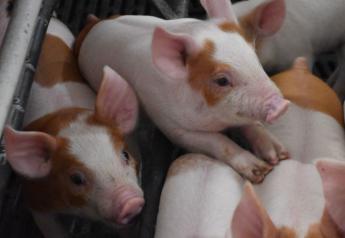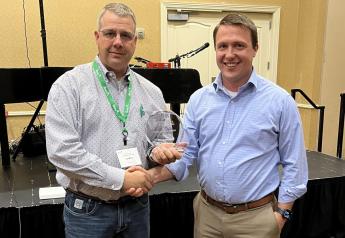African Swine Fever Survives in Feed, Now What?

In 2018, research confirmed the African swine fever (ASF) virus could survive in feed ingredients in a model that demonstrated the simulated movement of products from eastern Europe to the U.S.
“That study woke everybody up about the risk of ASF in feed,” says Scott Dee, director of research for Pipestone Veterinary Services.
Unfortunately, there’s not an easy solution to keep these products from entering the U.S. Due to trade agreements tied to many of these products, researchers began looking for other solutions to mitigate the risk posed by feed entering the U.S. from ASF-positive countries.
One question that weighed heavy on Dee’s mind was how does this feed enter the U.S.?
Dee sought help from Gilbert Patterson, currently the chief medical officer of the veterinary telemedicine and technology company, VetNOW. In 2014, there was a lot of speculation in the swine industry that porcine epidemic diarrhea virus (PEDV) was being transmitted in feed. It quickly became apparent that a better understanding of international swine feed ingredient sourcing was needed to identify risks to the swine supply chain.
As part of Patterson’s master’s degree in public health project at the University of Minnesota, he developed an analytical PivotTable -based tool that allowed him to track and categorize how and where different feed ingredients of interest entered the country, and also described how these products are classified and handled at border entry points.
Could his system be adapted to help the U.S. pork industry determine the ports of entry for high-risk feed products coming from ASF-positive countries?
“This was the first step – we needed to identify where the gun was and where the bullets were coming from,” Dee adds.
How do risky feed ingredients enter the U.S.?
In previous work, researchers had established that soy-based feed ingredients seemed to help viruses survive.
“We focused this study published in Transboundary and Emerging Diseases strictly on soy-based products,” Dee says. “I consider them the highest risk feed ingredient for ASF. Our thought was that if we knew the highest-risk ports, we could focus biosecurity efforts better.”
The first thing the team did was determine a list of ASF-positive countries that shipped soy-based products to the U.S. The countries that came to the top of Patterson’s list for 2018-2019 were China, the Ukraine, and Russia.
Then, using the United States International Trade Commission website to extract data on where all goods imported to the U.S. come from, Patterson applied his PivotTable system to isolate which ports these soy-based feed ingredients entered the country from.
They discovered products coming from China mostly entered West Coast ports like San Francisco or Seattle. However, the Ukrainian feed ingredients were not so easy to pinpoint – they entered from a variety of locations, including Charlotte, N.C., and New Orleans.
“The data shows in certain cases, there's a small set of ports where you could focus your efforts to protect the country. But we must be careful not to focus just on one country, because other countries are involved such as Russia and the Ukraine, and they're bringing in products to very different places,” Dee says.
China may get the most attention, but Dee says other countries pose major concern, too.
Identify the hotspots
The beauty of Patterson’s tool is that it allows the information to be presented in a way that can provide important decision-making information quickly. Rather than try to deal with all of the 325 Ports of Entry overseen by U.S. Customs and Border Protection where feed and feed ingredients can enter the U.S., efforts can be focused on certain ports and be adjusted as disease pressures and threat levels change.
In 2019, Canada developed secondary control zones around their ports. Dee explains that if product comes in from an ASF-positive country, it then sits in a designated holding area for a period of time to allow the virus to decay before they are released into the domestic food chain and animal food chain.
“Ideally, here in the U.S., we would do the same thing – we’d identify the high-risk ports, organize holding zones around those ports for these high-risk ingredients, and then let them sit in a designated warehouse,” Dee says.
Many producers are doing this on their own – implementing a responsible imports program. The problem is that it is not universally adopted in the U.S.
“We need a national program that identifies these hotspots, or high-risk ports. Then, we can implement a control zone around them,” Dee says.
Patterson believes this is important to producers because it can provide a little peace of mind and understanding.
“It's easy to wonder and think about, ‘Well, where does this product come from that I'm feeding to my pigs or injecting my pigs with?’ A lot of that traceability piece is not there, and it gets harder, the further and further you get into the supply chain.”
Just having an idea of where things are coming from that we potentially feed to our pigs, and identifying what might be risky out there, is a key step in allocating the resources and risk management.
“As things change in the world, as disease outbreaks happen, the status of certain products might change as well. So if there's a new break of ASF, somewhere in Europe for instance, and it turns out that we're bringing in a lot of soy products from one of those countries, we can identify where the most high-risk channels and take steps to mitigate some of that risk,” Patterson says.
A unique approach
“The beauty of this process is that you have the freedom to choose what you want to look for,” Patterson says. “If there's concern about a vitamin coming from Asia, or a particular grain coming from South America, for example, you can check and see how much of that product is coming in, and into which U.S. seaport.”
He says it allows you to then determine if it is a reasonable product to be concerned about by applying this data back to the risk management side of known potential risk channels.
“This work is really neat because it is the first time that this tool been on its own as the showcase of the research article,” Patterson says. “Whereas before, it's been part of papers answering questions about ASF’s survival in feed. This is really showcasing the process of getting that data to justify concerns of virus survivability in feed and international ingredient sourcing.”
And his work doesn't just apply to the swine industry.
“It applies to any sort of food safety or food defense interest that someone has about a different product coming from another country,” Patterson says. “This tool can help you quickly get answers to potential products of concern.”
Read More from Farm Journal's PORK:
How Long Does African Swine Fever Live in Feed?
5 Ways to Extend Biosecurity into the Feed Supply Chain
Reduce the Risk of African Swine Fever Virus Transmission in Feed







